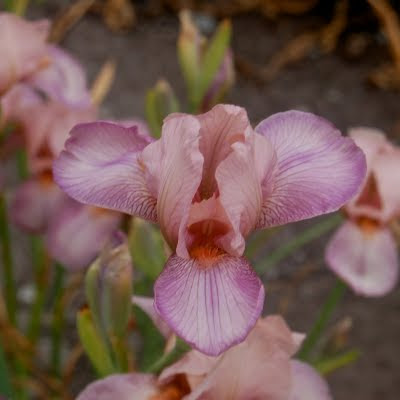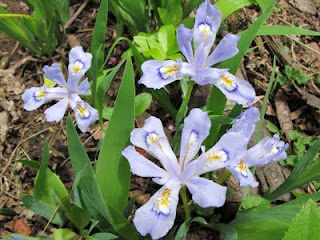 Often, yellow Louisiana irises get too little respect. There was a day when they were rare and prized.Yellow is a recessive color in two of the five Louisiana species: I. fulva and I. nelsonii. At the height of the collecting days before 1940, it was a treat to discover a yellow fulva. It still is today.
Often, yellow Louisiana irises get too little respect. There was a day when they were rare and prized.Yellow is a recessive color in two of the five Louisiana species: I. fulva and I. nelsonii. At the height of the collecting days before 1940, it was a treat to discover a yellow fulva. It still is today.Yellow nelsonii was even more rare, primarily because that species is limited to a few square miles southeast of Abbeville, Louisiana. At least for those collected irises that were subsequently registered, there were no more than a handful of yellows, but the yellow genes were there, lurking in the background of the red species and ready to burst forth in hybridizing.
T he true yellow form of I. nelsonii appeared lost until recently rediscovered by Benny Trahan. It is the typical mustard yellow, perhaps with a hint of orange, in contrast to the lighter, cleaner yellow of most fulva examples. (Go here for links to the story of Benny's yellow nelsonii).
he true yellow form of I. nelsonii appeared lost until recently rediscovered by Benny Trahan. It is the typical mustard yellow, perhaps with a hint of orange, in contrast to the lighter, cleaner yellow of most fulva examples. (Go here for links to the story of Benny's yellow nelsonii).
In fact there is a range of yellow shades in fulvas in the wild, from the clean light yellow of ‘Marvell Gold’, discovered in Arkansas, to the butterscotch of Steve Shepard’s ‘Lottie Butterscotch’, found a few years back near Lottie, Louisiana, due west of Baton Rouge.
The real reason for any lack of respect for yellow Louisianas has to be laid at the doorstep of I. pseudacorous, at least along the Gulf Coast. Here, where bearded irises are problematic and seldom seen, pseudacorous will flourish, even in areas where it has no business flourishing. It is an exotic species that, like Louisianas, enjoys a bayou or freshwater marsh habitat. It will escape, establish itself and crowd out other plants, including Louisiana irises. In a few areas, it is a genuine problem.
The gardening public sees pseudacorus all around. The yellow form of the species is nothing if not vigorous, so there is plenty available. Landscapers use it, even sometimes when they believe they are planting Louisiana irises. Many people picture pseudacorous even when talking about Louisianas.

The number one question iris society members are asked at gardening events, is, “Why aren’t my yellow Louisiana irises blooming?” This triggers a standard narrative: “Do your irises have a midrib? If so, they are not Louisiana iris... Don’t try to mix them with Louisianas... They are great for foliage, but in garden beds as opposed to water do not bloom as reliably as Louisiana irises… You might want to get rid of those (and good luck)... Try some Louisianas... Louisiana irises do come in yellow but also every other color and many forms and, by the way, are actually native."
If there is a pseudacorous anti-defamation league, I don’t mean to get it riled up. I respect all the iris cousins and their extended families. Some of the pseudacorous hybrids looks especially interesting and I would like to try them. But as I write from New Orleans, the Louisiana irises are closer kin. Brothers and sisters, tight family. Our native irises get priority over guests, especially ones that sometimes misbehave. But first and foremost, gardeners should know what they have, or might be getting, and make informed choices.
There are plenty of modern Louisiana hybrids that can satisfy any craving for yellow. Just a few of the good ones include Harry Wolford’s ‘Edna Claunch’ and new ‘Love Of My Life’; Patrick O’Connor’s ‘Rigolets’; and Heather Pryor’s ‘For Dad’. The yellow line is not hard and fast, and such blends as Dorman Haymon’s ‘Praline Festival’ and Wolford’s bicolor ‘Roar Of The Tiger’ show yellow joining with other colors in spectacular combinations.
Like all Louisiana irises, the yellow ones continue to improve, with more and larger flowers, improved substance, good form and various embellishments. They will bloom well in a normal garden bed and are good neighbors to other plants. Model citizens, with a tradition of southern hospitality and creole flair.














































